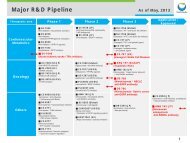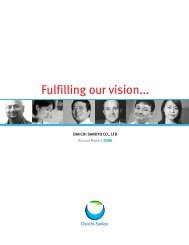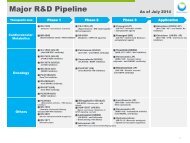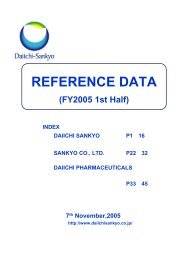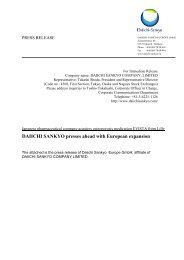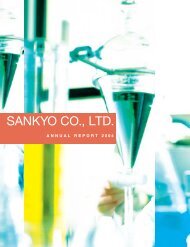Annual Report 2009 - Daiichi Sankyo
Annual Report 2009 - Daiichi Sankyo
Annual Report 2009 - Daiichi Sankyo
Create successful ePaper yourself
Turn your PDF publications into a flip-book with our unique Google optimized e-Paper software.
Held-to-maturity debt securities are stated at amortized cost. Equity securities issued by subsidiaries and affiliated companies<br />
which are not consolidated or accounted for by the equity method are stated at the moving-average cost. Available-for-sale<br />
securities with available fair market value are stated at fair market value. Unrealized gains and unrealized losses on these securities<br />
are reported, net of applicable income taxes, as a separate component of net assets. Realized gains or losses on the sale of<br />
such securities are computed using the moving-average cost method. The Companies have no trading securities.<br />
Derivative Transactions<br />
Derivatives are, in principle, stated at market value. The Company and certain consolidated subsidiaries enter into derivative<br />
agreements, such as forward foreign exchange contracts, currency options, interest-rate swaps, currency swaps, and call<br />
options on specific stocks, in order to manage the risk arising from fluctuation in foreign currency exchange rates, stock prices,<br />
and interest rates. Forward foreign exchange contracts and currency options are utilized to hedge risks arising from changes<br />
in foreign currency exchange rates in relation to imports and exports. Interest-rate swaps and currency swaps are utilized to<br />
manage interest-rate risk and risks arising from fluctuation in foreign currency exchange rates on debts. Call options on specific<br />
stocks are utilized to avoid the risk of fluctuation in stock prices relating to stock appreciation rights. The Company and its<br />
consolidated subsidiaries do not enter into derivative transactions for speculative trading purposes.<br />
Deferred hedge accounting is basically adopted.<br />
Forward foreign exchange contracts and currency options which meet hedging criteria are accounted for by the allocation<br />
method. The allocation method requires that recognized foreign currency receivables or payables be translated at the underlying<br />
exchange rates in the corresponding forward foreign exchange contracts and currency options. Interest-rate swaps and currency<br />
swaps which meet the criteria to qualify as hedges and satisfy certain criteria are accounted for by a special method stipulated<br />
in the accounting standard, as if the interest rates on the swaps were originally applied to the underlying borrowings. The<br />
Company and its consolidated subsidiaries which have derivatives positions have also developed hedging policies to control<br />
various aspects of these transactions, including establishing authorization levels and limits of transaction volumes.<br />
The effectiveness of hedges is generally measured by comparing the cumulative change in the fair value of the hedge item<br />
with the cumulative change in the fair value of the hedged subject. However, the effectiveness of the forward foreign exchange<br />
contracts of the Company as hedges has not been assessed as the conditions of these transactions are principally the same,<br />
and the effectiveness of the interest-rate swaps of the Company accounted for by the special method as highly qualified hedges<br />
has also not been assessed, as permitted under the accounting standard.<br />
Inventories<br />
Inventories were accounted for at the lower of cost (principally by the weighted-average method) or market until March 31,<br />
2007. Effective from the year ended March 31, 2008, inventories held for sales in the ordinary course of business have been<br />
accounted for at the lower of weighted-average cost or net realizable value. Replacement cost may be used in lieu of the net<br />
realizable value, if appropriate.<br />
This change in accounting method in the year ended March 31, 2008 was an early adoption of the Accounting Standard for<br />
Measurement of Inventories (Accounting Standards Board of Japan Statement No. 9, July 5, 2006) which has been mandatory<br />
from the year ended March 31, <strong>2009</strong>, by the Company and its domestic consolidated subsidiaries.<br />
As a result, operating income and income before income taxes and minority interests decreased by ¥2,993 million and<br />
¥2,311 million, respectively.<br />
Property, Plant and Equipment<br />
Depreciation of property, plant and equipment (except for certain buildings) is computed by the declining-balance method<br />
based on the estimated useful lives of the respective assets as to the Company and its domestic consolidated subsidiaries.<br />
Depreciation of buildings (other than structures attached to the buildings) acquired on and after April 1, 1998 by the Company<br />
and its domestic consolidated subsidiaries is computed by the straight-line method.<br />
As to the overseas consolidated subsidiaries, depreciation of property, plant and equipment is computed principally by the<br />
straight-line method.<br />
The range of useful lives was from 15 to 50 years for buildings and structures, and from 4 to 7 years for machinery, equipment<br />
and vehicles until March 31, 2008. Effective from the year ended March 31, <strong>2009</strong>, the range of useful lives for machinery,<br />
equipment and vehicles has been changed to 4 to 8 years, which is based on the reassessment of the useful lives in light of the<br />
change in the Japanese Corporation Tax Law, although the range of useful lives for buildings and structures remains<br />
unchanged. The effects of this change were immaterial.<br />
The Company and its domestic consolidated subsidiaries changed the method of depreciation for all tangible fixed assets<br />
acquired on or after April 1, 2007 to the straight-line method or the declining-balance method prescribed in the amendments of<br />
the Japanese Corporation Tax Law, the Law to Amend Part of the Income Tax Law (Cabinet Order No. 83, March 30, 2007).<br />
As a result, operating income and income before income taxes and minority interests decreased by ¥1,351 million and<br />
¥1,359 million, respectively.<br />
50<br />
<strong>Daiichi</strong> <strong>Sankyo</strong> Co., Ltd. <strong>Annual</strong> <strong>Report</strong> <strong>2009</strong>




